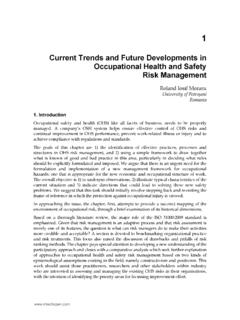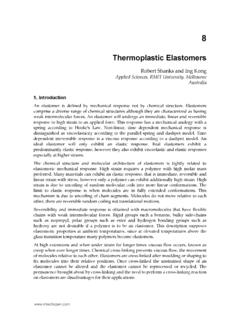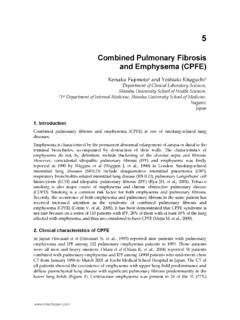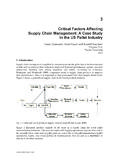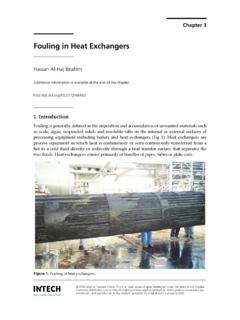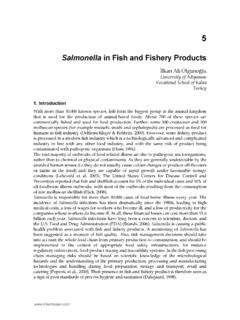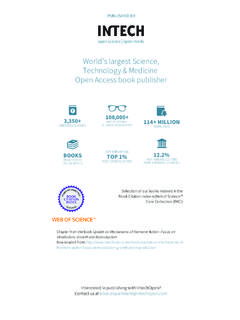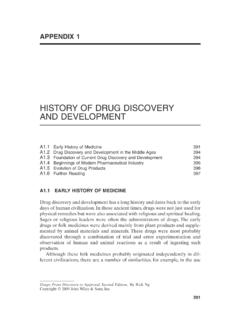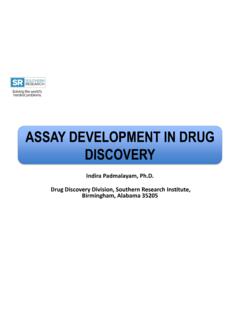Transcription of Drug Designing, Discovery and Development Techniques
1 2. drug designing , Discovery and Development Techniques Elvis A. Martis1 and Rakesh R. Somani2. 1 Department of Pharmaceutical Chemistry, Bombay College of Pharmacy, Santacruz [E], Mumbai, 2 Department of Pharmaceutical Chemistry, College of Pharmacy, Chembur [E], Mumbai, India 1. Introduction Human body is a complex chemical machinery, with as many as thousands of chemicals, namely proteins, carbohydrates, fats, etc. which exist all together. Every process in the body is some sort of chemical conversion that leads to movements, thought processes, feelings, pain and many more such complex as well as simple processes. The human body has also been provided with all the necessary chemical components or precursors, various enzymes and neurotransmitters for the balanced and proper functioning of all the life sustaining processes. Yet it so happens that some machineries or bioprocesses fail to function due to several exogenous or endogenous factors.
2 Hence providing external aids, which we call Drugs or Medicines , becomes essential to restore the normal functioning. Drugs are nothing but chemical entities of synthetic or natural origin, which only modulate the body functions and have no new action on the body. This explanation however does not fit the chemotherapeutic agents used to treat parasitic infections, as they have no action on the human body, but, are targeted to the invading organism (Richard et al., 2009). The exogenous factors are varied right from parasitic invasion to some chemical entities which tend to disrupt the normal bodily functions. Hence repairing becomes mandatory, if bodily repair mechanism cannot match the rate of damage. The endogenous factor maybe faulty, functioning of organs, any genetic or congenital factor, over or under-production of some precursors which may lead to disorders.
3 The classical examples of disorders due to endogenous factors are the neurodegenerative disorders like Parkinsonism and Alzheimer's disease which arise due to the imbalance of acetylcholine and dopamine in the central nervous systems. Though there is no cure for these disorders but drugs and therapies have been developed to prolong and improve the quality of life. (Moore et al., 2005; Cummings et al., 1998). Hence, drug Discovery can also called as patient-oriented science meant for improving the quality of life by developing newer and safer agents. drug Discovery plays an important role for the growth of any pharmaceutical industry and also to the society, as newer and safe drugs are launched in the market with the view to 20 Promising Pharmaceuticals improve the therapeutic value and safety of the agents. The pharmaceutical industry has consistently shown that it can discover and develop innovative medicines for a wide range of diseases (Ratti & Trist, 2011).
4 The revenue that flows in with the invention of newer agents has always been the motivation for the industry to keep up the pace and keep abreast with the ever increasing demand for medicines. The advent of molecular biology, along with numerous developments in the screening and synthetic chemistry technologies, has allowed learning both, the knowledge about the receptor and random screening to be used for drug Discovery . Today, more or less all pharmaceutical industries follow common Techniques for discovering drugs. These include cloning and expressing human receptors and enzymes in formats that allow high- throughput screening and the application of combinatorial chemistry. Thus, random screening can now be done with libraries sufficiently large and diverse to have a relatively high probability to find a novel molecule. These libraries are possible because they can be generated by the Techniques of combinatorial chemistry (Black, 2000).
5 drug research, as we know it today, began its career when chemistry had reached a degree of maturity that allowed its principles and methods to be applied to the problems outside of chemistry itself and when pharmacology had become a well-defined scientific discipline in its own right. By 1870, some of the essential foundations of chemical theory had been laid. Avogadro's atomic hypothesis had been confirmed and a periodic table of elements established. Chemistry had developed a theory that allowed it to organize the elements according to their atomic weights and valencies. There were set of theories of acids and bases. In 1865, August Kekul formulated his pioneering theory on the structure of aromatic organic molecules (Drews, 2000a and 1999b). During the first half of the 20th century drug research began shaping up and was developed by several new technologies, which carried the drug Discovery process to its best.
6 Biochemistry also had tremendous influence on drug research in many ways. The concept of targeting enzymes as drug targets came in to existence, that led to the designing of enzyme substrates which acted either as inhibitors or showed their action by modifying various feedback mechanisms. (Meidrum & Roughton, 1933). Table 1 shows some important discoveries in the field of medicine, right from 19th century to 21st century Sr. no Year of Discovery drug Name Category 1. 1806 Morphine Hypnotic agent 2. 1899 Aspirin Analgesic and Anti-pyretic agent 3. 1922 Insulin Anti-Diabetic agent 4. 1928 Penicillin Antibiotic 5. 1960 Chlordiazepoxide Tranquillizer 6. 1971 L-dopa Anti-Parkinson agent 7. 1987 Artemisinin Anti-malarial agent 8. 1998 Sildenafil Erectile Dysfunctioning treatment 9. 1999 Celecoxib, Rofecoxib Selective COX-2 inhibitors 10.
7 1999 Zanamavir, Anti-influenza agents Oseltamivir 11. 2001 Imatinib Leukemia treatment Table 1. Important discoveries in medicine drug designing , Discovery and Development Techniques 21. The present day drug Discovery process is a very time consuming process as it takes at least 14-16 years of research for a molecule to completely transform into a drug . There are several 100 basic research projects, before desired molecule is discovered. But, this molecule is not yet ready to be called as a drug . After the pre-clinical establishment and confirmation of its action and toxicity data, the FDA approves the candidate for clinical studies. The Clinical phase of the study takes at least 6-8 years, before the candidate can be launched in to the market. After this stage, the molecule is said to have transformed from a molecule to drug .
8 Even after the launch of the drug in the market, the post-marketing surveillance and pharmacovigilance program is being carried out to find out whether any new adverse reaction or incompatibilities towards other agents, when given as combination therapies. (Congreve, et al., 2005). Figure 1 depicts the entire drug Discovery process with the tentative timeline. Fig. 1. drug Discovery and Development process (Lombardino and Lowe, 2004). 2. drug Discovery process drug Discovery process basically is a patient oriented science, where researchers strive to improve the existing drugs or invent a totally new chemical entity, which should be ideally more potent than any existing drug of a similar category. If not, then at least it should be safer than those existing. This process is a very time consuming and expensive activity, calling for the expertise of many eminent researchers.
9 It takes nearly 12-14 years of exhaustive research and a huge amount of financial investment for the Discovery of a single drug . Right from the chemical synthesis to its clinical Development and finally formulating it to a suitable form. Failure at any stage would mean a huge loss for the company. Hence, a lot of planning is required even before the project is underway. Recently, with the use of technology the process is becoming a less risky business, because of the ability of the computers to predict the possible outcomes. This will surely reduce the efforts in fruitless directions (Augen, 2002). 22 Promising Pharmaceuticals The following paragraphs shall discuss the various stages of drug Discovery process. Identification of biological targets The human body functions normally by the virtue of the biochemical process which go on, producing all the necessary chemicals required for numerous functions to undergo smoothly within the body.
10 Many of these processes are regulated by the enzymes and the endogenous effector molecules via their respective receptors. A diseased state, may hence, be identified by, either the abnormal biochemical functioning or, over or underproduction of some of the intermediates. Hence , the most important and most common biological targets for drug Discovery are either enzymes regulating the biochemistry or the receptors through which many hormones and endogenous effectors show their response. For example, inhibition of human dihydrofolate reductase, by methotrexate, brought under control the growth of tumour in humans (Borsa and Whitemore, 1969). Similarly, blocking of the beta- adrenoceptors in the cardiac muscles was found to reduce the hypertensive state (Pearson, et al., 1989). Another type of biological targets are nucleic acids.
